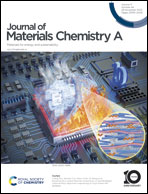Ultra-high dispersion of Ni-based OER catalysts on graphene 3D networks enhances the in situ Fe3+ catalytic activation†
Abstract
Hydrogen as an energy carrier plays a significant role in tackling energy transition challenges. Its production via water electrolysis can be powered by renewable sources of energy and it has been identified as the key to a secure and sustainable energy system. Therefore, the development of efficient and abundant electrocatalysts is very important to realize the required large-scale production. In this context, transition metals have been postulated as promising alternatives to noble metal oxides for water splitting in alkaline media. The efficient incorporation of these metals into supports can improve their distribution and particle size control, making carbon supports an ideal choice due to their high conductivity and electrochemical stability. In this work, reduced graphene oxide 3D aerogels doped with very low concentrations of nickel were prepared by freeze-casting. A fully water-based approach that enables an outstanding integration of nickel hydroxide precursor in a colloidal graphene oxide (GO) aqueous suspension was developed. The as-prepared Ni/graphene 3D networks were extensively characterized showing a low loading of nickel (<10 wt%), and ultradispersed, and nanosized Ni-based particles (15–40 nm). Electrochemical experiments show that Ni/graphene 3D networks exhibit very good catalytic properties towards the oxygen evolution reaction (OER) and outstanding Fe-ion activation from the impurities present in the alkaline (KOH 1 M) electrolyte media. Previous studies have shown that Fe incorporation can increase two-fold the activity of Ni-based electrocatalysts. In contrast, the ultradispersed Ni/graphene hybrid prepared here exhibits an impressive over ten-fold performance increase, highlighting the remarkable influence of Fe in these materials. The high-dispersion and surface availability of Ni species promotes the in situ formation of highly active Ni–Fe oxyhydroxide on the surface of the catalysts.



 Please wait while we load your content...
Please wait while we load your content...